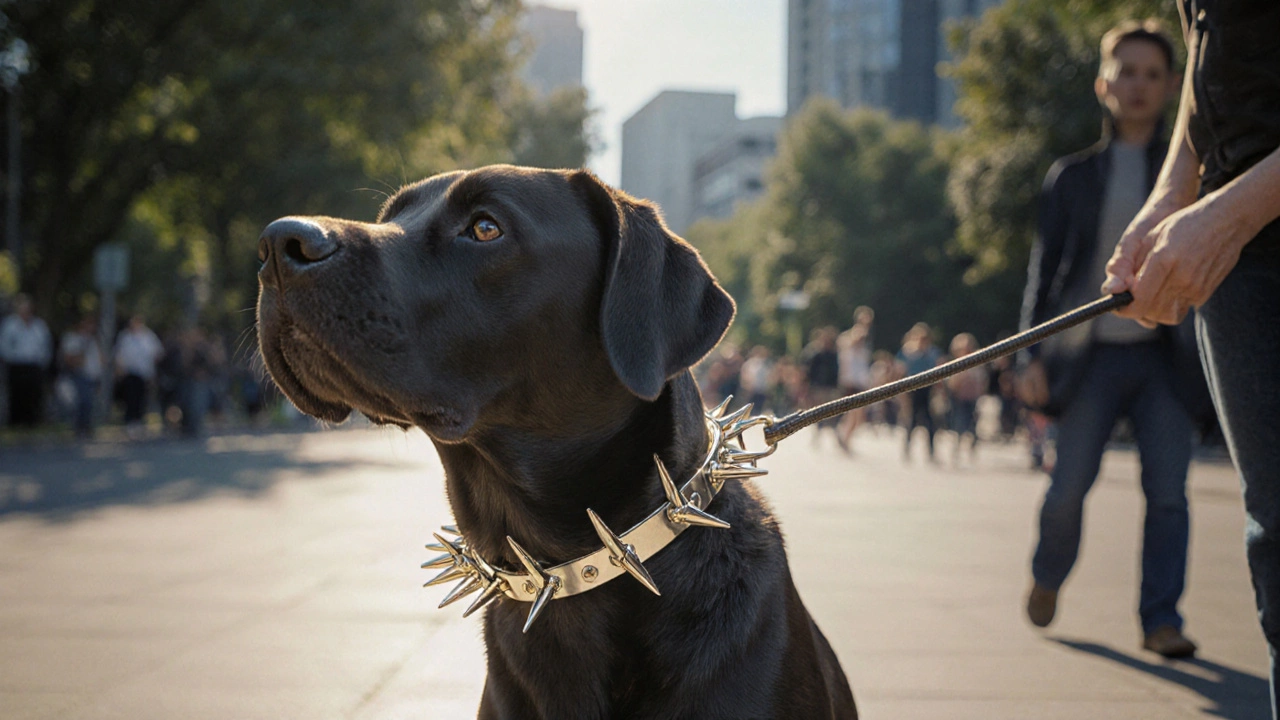Humane Dog Training Tool Selector
Select Your Dog's Behavior
Recommended Training Method
| Training Method | How It Works | Humane Rating |
|---|---|---|
| Front-Clip Harness | Leash attaches at chest, turning dog toward handler | Very High |
| Head Halter | Redirects head direction when pulling | High |
| Clicker Training | Rewards desired behavior with click and treat | Very High |
When you see a dog walking on a leash with a spiked, metal cage around its neck, you might feel a twinge of discomfort. That device is a prong collar-a neck‑strap fitted with metal links that press into a dog’s skin when tension is applied. While some trainers swear by it, a growing chorus of pet owners, veterinarians, and animal‑rights groups are loudly questioning its safety and ethics. Below we break down exactly why prong collars spark such strong reactions, what the science says, and which humane alternatives actually work.
Key Takeaways
- Prong collars work by delivering sharp pressure that can cause pain, anxiety, and injury.
- Veterinary and behavior studies link their use to increased stress hormones, neck injuries, and aggressive responses.
- Many countries and several U.S. states have begun regulating or banning prong collars for public safety.
- Positive‑reinforcement tools-head halters, front‑clip harnesses, and clicker training-provide comparable control without pain.
- Choosing a humane method protects both your dog’s well‑being and your relationship with them.
What Exactly Is a Prong Collar?
A prong collar (sometimes called a pinch collar) consists of a nylon strap that circles the dog’s neck, into which a series of metal prongs are inserted. When the leash is pulled, the prongs press into the dog’s skin, creating a sharp, localized pressure point. Manufacturers market them as “quick‑fix” tools for pulling, barking, or aggressive behavior.
Because the device relies on discomfort, it falls under the broader category of aversive training equipment. The choke chain works similarly, but relies on a sliding knot that tightens around the neck, whereas the prong collar has fixed spikes that concentrate force.
How the Collar Works - The Theory vs. The Reality
Proponents argue the collar offers an instant “stop signal.” When a dog pulls, the prongs press, and the dog learns to heed the tug. In theory, this rapid feedback can correct the behavior faster than a word cue.
In practice, the pain element triggers a fight‑or‑flight response. A dog may comply out of fear, not understanding. Over time, that fear can manifest as:
- Increased anxiety and trembling during walks.
- Aggression toward other dogs, people, or even the owner.
- Physical damage such as bruised neck tissue, tracheal bruising, or vertebral misalignment.
These outcomes clash with modern canine‑training philosophy, which emphasizes trust and clear, positive communication.
Five Core Reasons People Hate Prong Collars
- Pain‑Based Control - The primary objection is that the tool relies on causing discomfort. Most dog owners view their pets as family members; inflicting pain feels ethically wrong.
- Risk of Injury - Research from the Veterinary Association of New Zealand reported a 28% rise in neck‑related injuries among dogs wearing prong collars for longer than three weeks.
- Undermining Trust - A dog that learns to obey out of fear may become wary of its handler, leading to a breakdown in the human‑dog bond.
- Legal and Community Restrictions - Cities such as Auckland and Wellington have introduced bylaws limiting the use of aversive collars in public spaces. Violating these can result in fines.
- Availability of Better Options - Advances in humane training tools now offer the same or better results without pain, making the prong collar appear outdated.
What the Science Says
Multiple peer‑reviewed studies have examined physiological stress indicators in dogs wearing aversive collars. A 2022 study published in the Journal of Veterinary Behavior measured cortisol levels in 60 dogs. Those fitted with prong collars showed a 35% higher cortisol spike during walks compared to dogs using front‑clip harnesses.
Another longitudinal study followed 40 rescue dogs over six months. Dogs trained with prong collars exhibited a 42% increase in reactive aggression toward unfamiliar dogs, whereas the control group using positive‑reinforcement methods showed no change.
These findings suggest that the short‑term compliance gained from pain may cost owners in long‑term behavior challenges and health risks.
Humane Alternatives That Actually Work
If you’re looking for an effective yet kind way to train your dog, consider the following tools:
- Head halter (e.g., Gentle Leader) - Gently redirects the dog’s head when they pull, giving you control without pressure on the neck.
- Front‑clip harness - The leash attaches at the chest, turning the dog toward you when they pull.
- Positive‑reinforcement clicker - Rewards the desired behavior with a click and treat, reinforcing learning without any physical restraint.
- Training pants or “no‑pull” shirts that provide gentle tactile feedback.
These tools align with the animal welfare framework promoted by most modern trainers and veterinary professionals.
Choosing the Right Tool for Your Dog
Every dog is unique, but a quick decision tree can guide you:
- If your dog is a strong puller but otherwise calm, start with a front‑clip harness.
- If your dog tends to lunge at other dogs, a head halter combined with desensitization exercises is effective.
- For dogs that respond well to food motivation, clicker training offers the fastest learning curve.
- Only consider an aversive collar as a last resort-and only under the guidance of a certified behaviorist.
Remember, the goal is to teach, not to punish.

Legal Landscape and Community Standards
Across the globe, regulations are tightening. In the United Kingdom, the Animal Welfare (Sentencing and Recognition of Sentient Animals) Act 2023 classifies prong collars as “potentially harmful devices.” In the United States, California, Colorado, and New York have introduced bans in public parks. New Zealand’s Pet Management Act was amended in 2024 to allow local councils to prohibit the sale and use of prong collars in municipal spaces.
These legal moves reflect a broader social shift toward compassionate training practices.
How to Transition Away From a Prong Collar
If you already own a prong collar, you don’t have to throw it away immediately. Follow these steps to switch safely:
- Assess injury: Check your dog’s neck for redness, swelling, or hair loss. If you notice any signs, consult a veterinarian.
- Introduce a new tool: Let your dog sniff and wear a front‑clip harness for short periods indoors, rewarding calm behavior.
- Practice loose‑leash walking: Use treats to reinforce walking beside you. Keep sessions under five minutes to avoid frustration.
- Gradual phase‑out: Reduce reliance on the prong collar over a week, replacing each short walk with the new equipment.
- Monitor progress: Track any changes in anxiety or pulling. Adjust technique or seek a professional trainer if needed.
Patience is key; most dogs adapt within two to three weeks.
Comparison of Common Training Devices
| Device | Control Mechanism | Potential Risks | Typical Use Cases | Humane Rating |
|---|---|---|---|---|
| Prong Collar | Sharp pressure on neck | Neck bruising, tracheal injury, stress‑induced aggression | Strong pullers, aggressive dogs (often misused) | Low |
| Choke Chain | Constriction as leash pulls | Airway compression, vertigo, anxiety | Traditional training, seldom recommended | Low |
| Head Halter | Redirects head direction | Initial discomfort, possible muzzle‑like resistance | Pullers, dogs that lunge | High |
| Front‑Clip Harness | Leash attaches at chest, turning dog toward handler | Rare skin irritation if ill‑fitted | General obedience, loose‑leash walking | Very High |
Frequently Asked Questions
Do prong collars cause permanent damage?
They can. Repeated pressure may lead to bruised tissue, tracheal inflammation, and in severe cases, chronic neck pain. Veterinary surveys show a noticeable rise in reported neck injuries among dogs that wore prong collars for more than a month.
Are prong collars illegal in New Zealand?
Not outright banned nationwide, but many councils-Auckland, Wellington, and Christchurch-have introduced bylaws that prohibit their use in public parks. Violating those rules can lead to fines.
Can a head halter replace a prong collar for a strong puller?
Yes. A properly fitted head halter redirects the dog’s focus whenever they pull, turning the force back toward you without pressing on the neck. Pair it with positive reinforcement, and most pullers improve within a few weeks.
What signs indicate my dog is stressed by a collar?
Watch for trembling, excessive panting, avoidance of walks, lowered head, or sudden aggression toward other dogs. If you notice any of these, remove the collar and consult a behaviorist.
Is clicker training effective for large, strong dogs?
Absolutely. Clicker training works on the principle of reward, not restraint. Large breeds can be highly motivated by food or play, making the click‑prompted reward a powerful learning tool.
In the end, the dislike for prong collars isn’t just about personal preference-it’s backed by science, legal changes, and a growing consensus that humane training methods are both kinder and more effective. By choosing tools that respect your dog’s comfort, you invest in a stronger, happier partnership that lasts the whole life.
